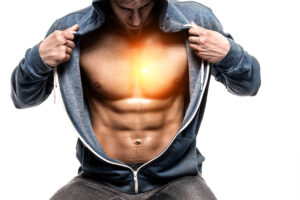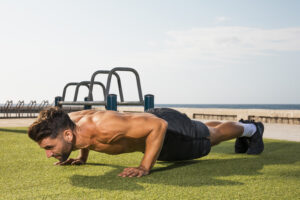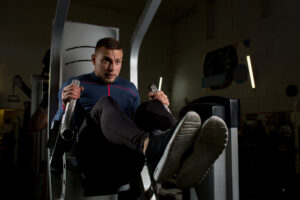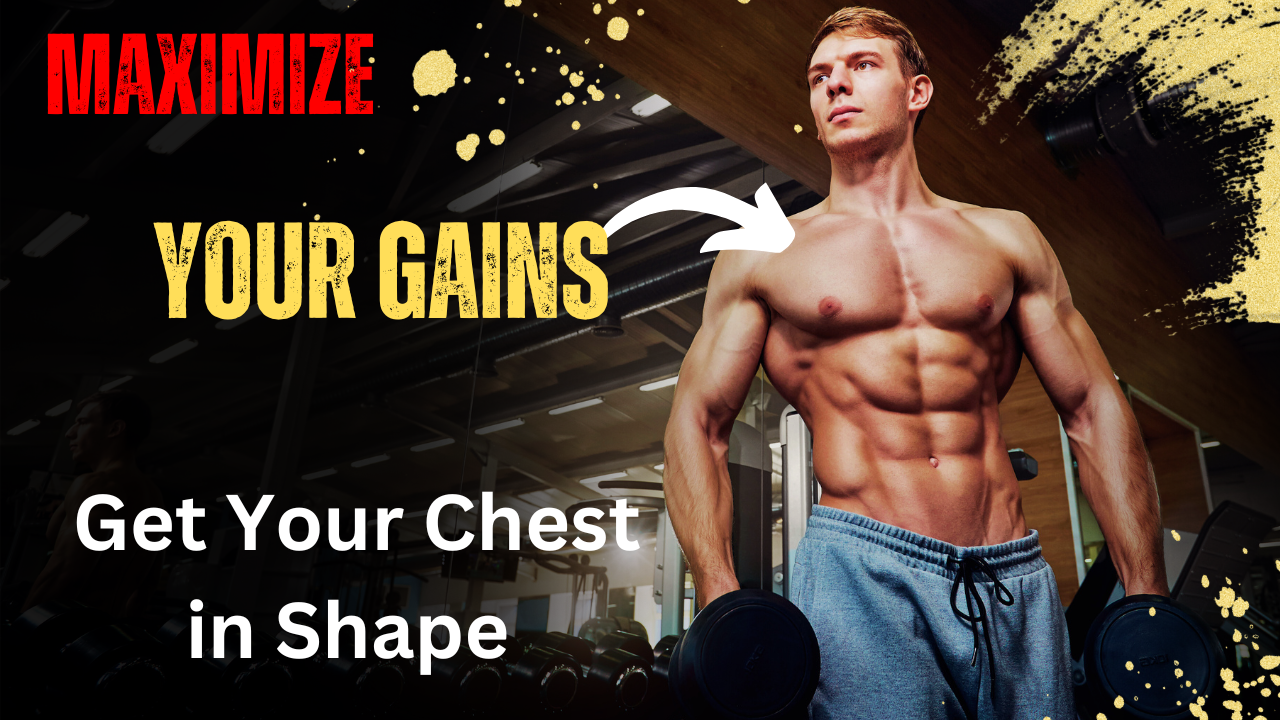introduction:
Losing chest fat can be a challenging yet rewarding journey, especially from the comfort of your home. Whether you’re aiming for a more toned physique or improving your overall health, dedicating just one month to focused exercises and healthy lifestyle choices can make a significant difference.
This 1-month challenge is designed to help you shed excess chest fat through targeted workouts, balanced nutrition, and consistent habits. No gym membership or fancy equipment is required—just your commitment and determination to achieve your fitness goals. Let’s embark on this journey together and transform your chest in just 30 days.
Table of Contents
Understanding Chest Muscles and Exercises to Target Them

Before we begin, it’s essential to understand what chest fat is and why it accumulates. Chest fat, particularly in men, can be due to a variety of factors including genetics, hormonal imbalances, and poor lifestyle choices. This excess fat around the chest area can sometimes be a source of frustration and self-consciousness
. While it’s impossible to spot-reduce fat, focusing on overall body fat reduction will help you see significant improvements in your chest area. By combining effective exercises, a balanced diet, and healthy habits, you can work towards a leaner, more defined chest and improve your overall fitness and well-being.
Anatomy of the Chest Muscles
The chest is composed of several key muscles that work together to enable various upper-body movements. The primary chest muscles are:
Pectoralis Major: This is the largest chest muscle, covering most of the upper chest. It has two parts:
- Clavicular Head (Upper Chest): Located near the clavicle (collarbone).
- Sternal Head (Lower Chest): Extends from the sternum down to the rib area.
Pectoralis Minor: Located beneath the pectoralis major, this smaller muscle assists in movements of the shoulder and rib cage.
Serratus Anterior: Found on the side of the chest, this muscle helps move the shoulder blades.
Intercostal Muscles: These are the muscles between the ribs, aiding in the expansion and contraction of the chest during breathing.
Exercises Targeting Chest Muscles
Push-Ups
- Muscles Worked: Pectoralis major (both heads), pectoralis minor, triceps, and deltoids.
- Benefits: Push-ups are a fundamental bodyweight exercise that strengthens the chest and upper body. Variations like wide-grip push-ups emphasize the outer chest, while diamond push-ups target the triceps and inner chest.
Chest Press
- Muscles Worked: Pectoralis major (both heads), deltoids, triceps.
- Benefits: Using dumbbells or a barbell, the chest press is excellent for building overall chest strength. Adjusting the bench angle (flat, incline, or decline) can target different parts of the pectoralis major.
Chest Fly
- Muscles Worked: Pectoralis major (both heads), deltoids.
- Benefits: This exercise isolates the chest muscles, providing a deep stretch and contraction. Performing chest flies with dumbbells or resistance bands helps to sculpt and define the chest.
Bench Dips
- Muscles Worked: Pectoralis major (lower part), triceps, deltoids.
- Benefits: Bench dips are effective for targeting the lower chest and triceps. They can be done using a bench or chair, making them a versatile exercise.
Incline Bench Press
- Muscles Worked: Pectoralis major (clavicular head), deltoids, triceps.
- Benefits: By adjusting the bench to an incline, this exercise specifically targets the upper chest, helping to build a fuller, more rounded chest appearance.
Decline Bench Press
- Muscles Worked: Pectoralis major (sternal head), deltoids, triceps.
- Benefits: Performing the press on a decline bench emphasizes the lower chest, aiding in the development of the lower pectoral muscles.
Planks
- Muscles Worked: Core, pectoralis major, deltoids.
- Benefits: While primarily a core exercise, planks also engage the chest muscles, providing stability and strength to the upper body.
Which Muscle to Focus on for Losing Chest Fat?
While losing chest fat primarily involves reducing overall body fat through diet and cardiovascular exercise, strengthening and toning the chest muscles can help improve the appearance of the chest. Exercises that work the pectoralis major (both the clavicular and sternal heads) are particularly effective because they cover the majority of the chest area.
Clavicular Head: Exercises like the incline bench press and incline push-ups target the upper chest, helping to create a well-rounded chest appearance.
Sternal Head: The flat bench press, push-ups, and chest fly target the mid and lower chest, providing overall chest development and definition.
Overall Chest Development: Chest press and push-up variations engage multiple parts of the chest, promoting balanced muscle development.
Setting Realistic Goals
Define Your Objectives
 Before diving into any fitness challenge, it’s crucial to set realistic and achievable goals. Defining your objectives will help keep you motivated and focused throughout the journey. Here are a few steps to help you set clear and attainable goals for this 1-month challenge:
Before diving into any fitness challenge, it’s crucial to set realistic and achievable goals. Defining your objectives will help keep you motivated and focused throughout the journey. Here are a few steps to help you set clear and attainable goals for this 1-month challenge:
Identify Your Why: Understand the reasons behind your desire to lose chest fat. Whether it’s to boost your confidence, improve your health, or enhance your physical appearance, having a clear motivation will keep you committed.
Set Specific Goals: Instead of vague aims like “lose chest fat,” set specific targets such as “reduce chest measurement by 2 inches” or “perform 20 push-ups in a row.” Specific goals are easier to track and achieve.
Be Realistic: Understand that significant changes take time. Setting goals that are too ambitious can lead to disappointment and frustration. Aim for steady progress rather than drastic changes.
Create a Timeline: Break down your month into weekly milestones. For example, set weekly goals for the number of workouts, improvements in diet, or incremental fitness achievements.
Track Your Progress: Keep a journal or use a fitness app to log your workouts, diet, and any changes you observe. Regularly reviewing your progress will help you stay on track and make necessary adjustments.
By defining clear and realistic objectives, you’ll set yourself up for success and make your 1-month challenge both effective and rewarding.
Consistency is Key

Consistency is the cornerstone of any successful fitness journey. When it comes to losing chest fat, maintaining a routine is essential to see real results. Here are a few reasons why consistency is so important and how you can stay on track:
Builds Habit: Consistent actions lead to the formation of habits. By sticking to your workout and diet plan every day, you make these behaviors a natural part of your routine, reducing the effort needed to maintain them.
Ensures Progress: Regular exercise and a balanced diet ensure continuous progress. Skipping workouts or indulging in unhealthy foods too often can set you back and make it harder to reach your goals.
Improves Efficiency: Your body adapts to regular exercise by becoming more efficient. Consistent workouts improve your strength, endurance, and overall fitness, making each session more effective over time.
Boosts Motivation: Seeing consistent progress, even if it’s small, keeps you motivated. Tracking your daily achievements, such as completing a workout or sticking to your diet, provides a sense of accomplishment and encourages you to keep going.
Reduces Setbacks: Irregular efforts can lead to setbacks such as muscle soreness, fatigue, or loss of progress. Staying consistent helps maintain a steady pace, reducing the risk of injuries and keeping your momentum going.
To maintain consistency, create a realistic schedule that fits your lifestyle, set reminders, and find a support system to keep you accountable. Remember, the key to success is not in intense but sporadic efforts, but in regular, sustainable actions that gradually lead you to your fitness goals.
The Role of Diet in Losing Chest Fat

Diet plays a crucial role in losing chest fat and achieving your fitness goals. While exercise is important for building muscle and increasing metabolism, what you eat significantly impacts your overall body fat percentage. Here are some key dietary principles to help you reduce chest fat:
Caloric Deficit: To lose fat, you need to consume fewer calories than your body burns. Calculate your daily caloric needs and aim to eat slightly less to create a manageable deficit. Be careful not to cut too many calories, as this can slow down your metabolism and lead to muscle loss.
Balanced Nutrition: Focus on a diet rich in whole foods, including lean proteins, complex carbohydrates, healthy fats, and plenty of fruits and vegetables. This ensures you get the necessary nutrients for energy, muscle repair, and overall health.
Lean Protein: Protein is essential for muscle repair and growth, which can help improve the appearance of your chest. Include sources like chicken, turkey, fish, beans, and low-fat dairy products in your meals.
Healthy Fats: Not all fats are bad. Healthy fats, such as those found in avocados, nuts, seeds, and olive oil, can help you feel full and satisfied, preventing overeating.
Complex Carbs: Choose complex carbohydrates like whole grains, oats, quinoa, and sweet potatoes over simple sugars and refined carbs. These provide sustained energy and help regulate blood sugar levels.
Hydration: Drinking plenty of water aids in digestion, keeps you feeling full, and helps your body function optimally. Aim for at least 8 cups of water a day.
Avoid Sugary and Processed Foods: Foods high in sugar and refined ingredients contribute to fat accumulation. Limit your intake of sweets, sugary drinks, fast food, and processed snacks.
Portion Control: Be mindful of portion sizes to avoid overeating. Eating smaller, more frequent meals can help manage hunger and keep your metabolism active.
Meal Planning: Plan your meals and snacks ahead of time to ensure you have healthy options available and avoid the temptation of unhealthy choices.
By combining these dietary strategies with regular exercise, you can effectively reduce chest fat and improve your overall health. Remember, consistency is key, and making sustainable dietary changes will lead to long-term success.
Effective Exercises to Lose Chest Fat
 Combining a healthy diet with regular exercise is crucial for losing chest fat. Here are some effective exercises that target the chest area and help reduce overall body fat:
Combining a healthy diet with regular exercise is crucial for losing chest fat. Here are some effective exercises that target the chest area and help reduce overall body fat:
Push-Ups:
- Push-ups are a classic exercise that works the chest, shoulders, and triceps.
- Start in a plank position with your hands slightly wider than shoulder-width apart.
- Lower your body until your chest nearly touches the floor, then push back up to the starting position.
- Aim for 3 sets of 10-15 repetitions.
Chest Press:
- You can perform chest presses with dumbbells or resistance bands.
- Lie on your back on a bench or the floor, holding weights in each hand.
- Press the weights up until your arms are fully extended, then lower them back to the starting position.
- Aim for 3 sets of 10-12 repetitions.
Chest Flyes:
- Chest flies can be done with dumbbells or resistance bands.
- Lie on your back on a bench or the floor, holding weights in each hand with your arms extended above your chest.
- Slowly lower your arms out to the sides, keeping a slight bend in your elbows, then bring them back together above your chest.
- Aim for 3 sets of 10-12 repetitions.
Dips:
- Dips are effective for working the lower chest and triceps.
- Use parallel bars or a sturdy surface like a bench.
- Lower your body until your upper arms are parallel to the ground, then push back up to the starting position.
- Aim for 3 sets of 8-10 repetitions.
High-Intensity Interval Training (HIIT):
- HIIT involves short bursts of intense exercise followed by brief rest periods.
- Include chest-focused exercises like burpees, mountain climbers, or explosive push-ups.
- A typical HIIT session might be 20 seconds of intense exercise followed by 10 seconds of rest, repeated for 15-20 minutes.
Incline Push-Ups:
- Incline push-ups target the upper chest.
- Place your hands on a raised surface like a bench or step.
- Perform push-ups as you normally would, focusing on keeping your body in a straight line.
- Aim for 3 sets of 10-15 repetitions.
Cardio Exercises:
- Incorporate cardio exercises like running, cycling, or jumping rope to help reduce overall body fat.
- Aim for at least 150 minutes of moderate-intensity or 75 minutes of high-intensity cardio per week.
Plank to Push-Up:
- This exercise engages your chest, core, and shoulders.
- Start in a plank position on your forearms.
- Push up to a full push-up position one arm at a time, then lower back down to your forearms.
- Aim for 3 sets of 10-12 repetitions incorporating these exercises into your routine, you can effectively target your chest muscles and reduce chest fat. Remember, consistency and a balanced approach to diet and exercise are key to achieving the best results.
High-Intensity Interval Training (HIIT)
Incorporating Core Workouts

High-Intensity Interval Training (HIIT) is an efficient and effective workout method that alternates between short bursts of intense exercise and brief periods of rest or low-intensity activity.
This approach not only maximizes calorie burn in a shorter amount of time compared to traditional steady-state cardio but also boosts your metabolism, allowing you to continue burning calories even after the workout is over.
HIIT can include a variety of exercises such as sprints, burpees, jump squats, and push-ups, making it versatile and adaptable to different fitness levels. Additionally, incorporating chest-focused exercises like explosive push-ups or mountain climbers into your HIIT routine can specifically target chest fat while improving overall cardiovascular fitness. With its time-efficient nature and proven effectiveness, HIIT is an excellent addition to any fitness regimen aimed at losing chest fat and enhancing overall health.
Planks
Planks strengthen the core, which supports overall body stability. Hold the plank position for 30-60 seconds, 3 times a day.
Russian Twists
This exercise works the obliques and can help create a more defined torso. Perform 3 sets of 20 twists.
Leg Raises
Leg raises target the lower abs. Aim for 3 sets of 15 repetitions.
The Importance of Rest and Recovery

Rest and recovery are critical components of any fitness regimen, especially when working to lose chest fat and build muscle. While regular exercise and a balanced diet are essential, allowing your body time to rest and recover is equally important for achieving optimal results.
During rest periods, your muscles repair and grow stronger, which helps improve performance and prevent injuries. Overtraining can lead to fatigue, decreased performance, and even muscle loss, counteracting your efforts. Adequate sleep, hydration, and nutrition support the recovery process by providing the necessary resources for muscle repair and growth.
Incorporating rest days into your workout schedule, along with practices such as stretching, foam rolling, and light activities like walking or yoga, can enhance recovery and keep you on track toward your fitness goals. By prioritizing rest and recovery, you ensure that your body remains healthy, resilient, and ready to tackle each workout with renewed energy and strength.
Sleep
Adequate sleep is essential for muscle recovery and overall health. Aim for 7-9 hours of quality sleep each night.
Rest Days
Incorporate rest days into your workout routine to allow your muscles to recover and grow. Overtraining can lead to injuries and burnout.
Tracking Your Progress
 Tracking your progress is a vital aspect of any fitness journey, including your goal to lose chest fat. Monitoring your achievements and changes helps keep you motivated and provides insight into what works best for your body. Start by taking initial measurements of your chest, weight, and body fat percentage.
Tracking your progress is a vital aspect of any fitness journey, including your goal to lose chest fat. Monitoring your achievements and changes helps keep you motivated and provides insight into what works best for your body. Start by taking initial measurements of your chest, weight, and body fat percentage.
Use a journal or a fitness app to log your workouts, noting the exercises, sets, and repetitions you complete each day. Record your dietary intake to ensure you’re maintaining a caloric deficit and consuming balanced nutrition. Take progress photos weekly to visually document changes in your physique.
Regularly assess your performance improvements, such as increased strength, endurance, and flexibility. By consistently tracking your progress, you can celebrate small victories, identify areas that need adjustment, and stay focused on your long-term fitness goals. This structured approach not only enhances your commitment but also makes the process of losing chest fat more systematic and rewarding.
Keep a Journal
Document your workouts, meals, and progress in a journal. This helps to keep you accountable and motivated.
Weekly Check-Ins
Perform weekly check-ins by measuring your chest and weight. Take progress photos to visually track changes.
Staying Motivated

Find a Workout Buddy
Having a workout buddy can make exercising more enjoyable and keep you motivated.
Reward Yourself
Set small milestones and reward yourself when you achieve them. This could be a new workout outfit or a healthy treat.
Stay Positive
Stay positive and remind yourself of your goals. Progress may be slow, but consistency will yield results.
Common Challenges and How to Overcome Them
Embarking on a fitness journey to lose chest fat can be filled with challenges, but recognizing and addressing these obstacles can help you stay on track. Here are some common challenges and strategies to overcome them:
Lack of Time:
- Solution: Prioritize your workouts by scheduling them into your day like any other important appointment. Opt for shorter, high-intensity workouts such as HIIT that can be done in 20-30 minutes.
Plateaus:
- Solution: If you hit a plateau where progress stalls, try changing your routine. Introduce new exercises, increase the intensity, or adjust your diet to keep your body challenged.
Boredom:
- Solution: Keep your workouts interesting by varying the exercises, trying new fitness classes, or working out with a friend. Setting new fitness goals can also provide fresh motivation.
Inconsistent Motivation:
- Solution: Set specific, achievable goals and track your progress to see how far you’ve come. Reward yourself for reaching milestones and remind yourself of the reasons you started your journey.
Cravings and Diet Slip-Ups:
- Solution: Plan your meals and snacks to avoid impulsive eating. Allow yourself occasional treats in moderation to prevent feelings of deprivation. Focus on whole, nutritious foods that keep you satisfied.
Injuries:
- Solution: Listen to your body and don’t ignore pain. Ensure you’re using proper form and technique. Incorporate rest days into your routine and seek professional advice if you experience persistent pain.
Lack of Support:
- Solution: Find a workout buddy or join a fitness community for encouragement and accountability. Sharing your goals with friends and family can also provide support and motivation.
Impatience:
- Solution: Understand that significant changes take time. Celebrate small victories along the way and stay focused on the long-term benefits. Patience and consistency are key to lasting results.
By anticipating these challenges and having strategies to overcome them, you can maintain your motivation and continue making progress toward losing chest fat and achieving your fitness goals.
Final Tips for Success

Stay Consistent: Consistency is crucial. Stick to your workout and diet plan, even when progress seems slow. Regular efforts yield the best results over time.
Set Realistic Goals: Aim for achievable, incremental goals rather than expecting drastic changes overnight. Realistic goals help maintain motivation and prevent disappointment.
Focus on Whole-Body Fitness: While targeting chest fat, remember that overall body fitness is important. Incorporate a mix of cardio, strength training, and flexibility exercises into your routine.
Maintain a Balanced Diet: Eat a variety of nutrient-rich foods, including lean proteins, complex carbohydrates, healthy fats, and plenty of fruits and vegetables. Avoid processed foods and excessive sugar.
Hydrate: Drink plenty of water throughout the day to stay hydrated, support metabolism, and aid in muscle recovery.
Get Adequate Sleep: Ensure you get 7-9 hours of quality sleep each night. Sleep is essential for muscle recovery, hormone regulation, and overall health.
Listen to Your Body: Pay attention to how your body responds to workouts and dietary changes. Rest when needed and avoid pushing through pain to prevent injuries.
Conclusion
Embarking on a 1-month challenge to lose chest fat at home is an exciting and achievable goal. By following a balanced diet, incorporating a mix of cardio, strength training, and core workouts, and maintaining consistency, you’ll be well on your way to a healthier and more defined chest. Remember, the key to success is staying motivated, tracking your progress, and being patient with yourself. Let’s start this journey together and achieve your fitness goals.
FAQS
1. Can I really lose chest fat in one month?
While it’s possible to see noticeable changes in chest fat within a month, the results vary depending on individual factors such as starting fitness level, diet, and consistency in following the workout routine. Significant changes often take more time, but a month is a good start to establish healthy habits.
2. What type of diet should I follow to lose chest fat?
A balanced diet that is high in lean proteins, vegetables, fruits, and whole grains, while low in processed foods, sugars, and unhealthy fats, is essential. Maintaining a caloric deficit—burning more calories than you consume—is crucial for fat loss.
3. How often should I exercise to lose chest fat?
Aim for at least 5 days of exercise per week, combining cardio, strength training, and core workouts. Consistency is key to achieving and maintaining results.
4. Do I need any special equipment for this challenge?
No special equipment is required. Many effective exercises, such as push-ups, planks, and HIIT workouts, can be performed using just your body weight. Dumbbells or resistance bands can enhance your workout but are not necessary.
5. How important is cardio for losing chest fat?
Cardio is very important as it helps burn overall body fat, which includes chest fat. Incorporate at least 30 minutes of cardio exercises like jogging, cycling, or brisk walking into your routine.
6. Can I target chest fat specifically?
Spot reduction (losing fat from a specific area) is a common myth. Instead, focus on overall body fat reduction through a combination of diet and full-body workouts. Targeted chest exercises can help build and tone chest muscles.
7. How much water should I drink daily during this challenge?
Aim for at least 8 glasses of water a day to stay hydrated, support digestion, and help control hunger. Staying hydrated is crucial for overall health and weight loss.
8. How will I know if I’m making progress?
Track your progress by taking measurements of your chest, weighing yourself, and taking weekly photos. Keeping a journal of your workouts and diet can also help you stay accountable and motivated.
9. What if I hit a weight loss plateau?
Plateaus are common. To overcome them, try varying your workout routine, adjusting your caloric intake, or increasing the intensity of your workouts. Sometimes, small changes can restart progress.
10. Is rest important during this challenge?
Yes, rest is crucial. Ensure you get 7-9 hours of sleep each night and include rest days in your workout schedule to allow your muscles to recover and prevent overtraining.
11. Can I do this challenge if I’m a beginner?
Absolutely! This challenge is suitable for all fitness levels. Start at your own pace, and gradually increase the intensity of your workouts as you become more comfortable and stronger.
12. How can I stay motivated throughout the month?
Set small, achievable goals, find a workout buddy, reward yourself for milestones, and keep a positive mindset. Remind yourself why you started and celebrate your progress, no matter how small.
13. Should I consult a professional before starting this challenge?
If you have any pre-existing health conditions or concerns, it’s a good idea to consult a healthcare professional or a certified fitness trainer before starting any new exercise program. They can provide personalized advice and ensure your safety.
14. What other lifestyle changes can support my goal?
In addition to diet and exercise, reducing stress, avoiding alcohol and smoking, and ensuring adequate sleep can all support your weight loss and overall health goals.
15. Can women do this challenge?
Yes, this challenge is suitable for both men and women. The principles of diet, exercise, and consistency apply equally to everyone aiming to lose chest fat and improve their fitness.

